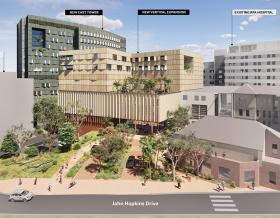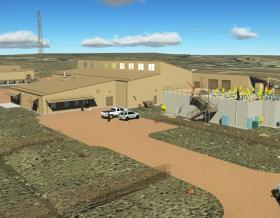




At Jacobs, we're challenging today to reinvent tomorrow by solving the world's most critical problems for thriving cities, resilient environments, mission-critical outcomes, operational advancement, scientific discovery and cutting-edge manufacturing, turning abstract ideas into realities that transform the world for good. With approximately $16 billion in annual revenue and a talent force of more than 60,000, Jacobs provides a full spectrum of professional services including consulting, technical, scientific and project delivery for the government and private sector.



For more than 70 years, our teams have provided integrated solutions to help solve the most complex and hazardous challenges of space exploration. We invent by imagining what’s possible.



A curated selection of some of the top-listened to and trending podcast episodes from our popular If/When podcast series, which has over 6M downloads to date.



Sit down with our visionary team of thinkers, dreamers and doers to see what a day in the life is like.
2c4e.jpg?h=c7c14dee&itok=FmPI2126)


As our clients navigate the digital transformation and growing cyber risks, we have positioned ourselves at the forefront of this growth, adding digital capabilities, products and tools to serve a growing set of customers.



Together with our visionary partner, PA Consulting, we're establishing our position in high end advisory services, creating a springboard to expand in high value offerings beyond the core.



The only certainty about the future is uncertainty. Resilience is an attribute of a smarter planet, and requires planning and adapting ahead of potential threats. We help our clients survive, recover, adapt and thrive.



Jacobs. A world where you can.



As a purpose-led company, we know we have a pivotal role to play in addressing the climate emergency. We consider this not only good business, but our duty to channel our technology-enabled expertise and capabilities toward benefitting people and the planet.



For more than 30 years, Jacobs has been responsible for planning and implementing Lead and Copper Rule-related strategies which protect millions of people in the U.S. and Canada. Our work includes enhanced water quality monitoring strategies, sampling plan development, harvested pipe-scale analysis, lead service line inventories and replacement plans, corrosion control studies and the incorporation of equity and environmental justice considerations into compliance programs.

_0ac2b.jpg?h=8a6d63f3&itok=5vsqFiQH)

Jacobs is working to help clients across the United States secure federal funding for projects that make our cities and communities more connected and sustainable. Working hand-in-hand with clients from coast to coast and everywhere in between, Jacobs develops bold, innovative solutions to address the nation’s toughest challenges.



Now more than ever, we appreciate the hard work, sacrifice and dedication of the medical profession in ensuring the health and safety of our communities.



Together, we are stronger. Together, we can transform the future.


2747.png?h=1314d3d4&itok=rFs9mG95)
We work in partnership, delivering some of the most challenging, diverse and innovative projects and programs globally across multiple sectors. We integrate complex interfaces across planning, procurement and delivery to help unlock better social, environmental and economic outcomes from mega and giga projects.



We’ve provided design-build services to the water sector for over 25 years and delivered more than 150 projects. We offer fully integrated design-build and design-build-operate capabilities to tackle the most complex water challenges and work in close collaboration with our clients.



As climate change threatens water security around the world, more communities are turning to water reuse as a resilient water supply solution and embracing the OneWater principle that all water has value. Jacobs has been supporting clients with water reuse programs for decades, beginning with the first applications of advanced wastewater treatment technologies in the 1960s. We provide our clients with a full range of services, from water reuse feasibility studies to design, construction and operations.



Jacobs’ deep experience with advanced technology systems and our wide-ranging program support capabilities make us a premier partner at locations across the world. We deliver the right talent, tools and processes to support and enable our customers’ missions.



The National Air and Space Museum's One World Connected exhibit will tell the story of how flight fostered two momentous changes in everyday life: the ease in making connections across vast distances and a new perspective of Earth as humanity’s home. Below are some stories from Jacobs that also highlight the connections and digital solutions we are making around the world.



Stories that capture our partnerships and innovative impact for a more connected, sustainable world



Traveling at 17,500 miles per hour, crewmembers aboard the International Space Station (ISS) sometimes need help seeing and identifying a wide assortment of status issues outside the station. Like a backup camera on a car, high-definition (HD) camera systems can function as the eyes of the astronauts, allowing many vantage points, angles and views in real-time. However, the space environment outside the ISS is extreme, and exposure without proper protection poses negative performance effects for technology.
But what if we showed you how Jacobs developed a portable, HD camera system that can withstand the thermal environment and be repositioned easily to help the crewmembers see and identify issues?
hours of continuous, rechargeable battery life for the camera, excellent for use on long duration space walks
spacewalks have been completed by International Space Station astronauts and cosmonauts since December 1998
“Our Jacobs video engineering team at the Johnson Space Center successfully led the effort to provide a practical camera solution for use on the International Space Station. The system may prove to become a standard for other vehicle systems that can be used on NASA’s new Lunar Gateway orbiting station and by astronauts walking on the surface of the moon.”
Kwaku Nornoo
Jacobs Chief Engineer, Johnson Space Center

Images courtesy of NASA

Images courtesy of NASA

Images courtesy of NASA
Jacobs took the initiative to design and develop the first portable wireless camera system for the ISS. We designed and built the system using commercially available components that are both rugged and low cost.
The Portable Wireless Camera (PWC) system will be used to capture HD video of target locations outside the space station and is designed to work inside a housing that protects the camera sensor from getting too hot or too cold. Signal connections from the camera to wireless modules outside the station use standard Wi-Fi and allow the camera to be moved and remounted easily. This adaptable system can provide different vantage points for astronauts and Mission Control while also saving the crew from repositioning expensive camera and control cables.
The camera streams 720p HD video and is compatible with existing Wi-Fi systems on the station, which allows streaming video to be sent live to Mission Control in Houston. For power, the camera uses a rechargeable battery with up to 10 hours of operation and can be used for long-duration space walks.
The PWC was launched in April aboard SpX-17 and is undergoing testing and deployment on the ISS. In the future, it’s possible that the camera system will be used to capture stunning video imagery on the surface of the Moon or even Mars.